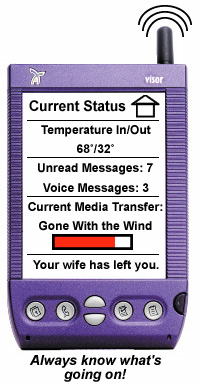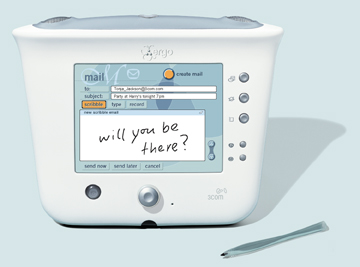After
six years of browsing the Internet, I am bored with the entire concept.
What I want the handheld world to do is focus less on wireless browsing
and more on wireless tools. We don't need more new ways to view the
content we are already ignoring. Let's face it, many content sites are
dying because nobody cares anymore. To me, wireless browsing on a handheld
is a big snore.
Let me illustrate my point with an example of one thing
that wireless should be. With the Visor  module
I mentioned (the hypothetical one controlling your personal server),
you could initiate a peer to peer file transfer between two people,
with the handhelds initiating the transfer between two personal home
servers. Not one bit of that file crosses their IR stream. The idea
that I could transfer a 1GB file to someone across the table from me
is real power. This makes Napster look like the telegraph. We have all
this bandwidth coming into our homes and offices. Why not use our handheld
to control and direct it? Let's not wait for wireless bandwidth to rival
the current state of fiber optic cables. Minimal packets of data could
move mountains, now!
module
I mentioned (the hypothetical one controlling your personal server),
you could initiate a peer to peer file transfer between two people,
with the handhelds initiating the transfer between two personal home
servers. Not one bit of that file crosses their IR stream. The idea
that I could transfer a 1GB file to someone across the table from me
is real power. This makes Napster look like the telegraph. We have all
this bandwidth coming into our homes and offices. Why not use our handheld
to control and direct it? Let's not wait for wireless bandwidth to rival
the current state of fiber optic cables. Minimal packets of data could
move mountains, now!
Imagine
that at every moment, your wireless Visor has a constant link to your
home server. It is always in sync, always in touch with your world.
We need to spend more time thinking of wireless and the handheld as
a way to direct information, not just contain it. There are all these
online hard-drive services giving you a whopping 25MB of storage for
free (wow). I have 50GB at home I already paid for and I want direct
access to that. I want to have a Baby Bell in my basement and I want
my Visor to be the switchboard.
The
Future is not Browsing the Internet on Your Fridge.
The current
computing flavor of the week is the Internet Appliance. The marketing
pitch they are pushing on us is building a better solution for Grandma.
Most Internet Appliances are built with the premise of making e-mail
and browsing easy for everyone. They are scaled down computers, with
no hard drive and a 56k modem. These devices generally rely on application
software often residing on a server somewhere out in the ether of the
Internet. Some have a built in OS (Unix, BeOS, etc.) but limited applications.
I see this as a misstep. Before you go spending $100 - $500 on an Internet
Appliance, ask yourself some questions. Do you want to be at the mercy
of the Internet Appliance manufacturer and their team of developers?
Do you want them dictating what software you can run or have to wait
for them to provide new services? Does your Internet Appliance communicate
with your PC over a network? Will this device be useful in 12 months?
Recently
3Com threw their hat into the Internet Appliance market by releasing
a shiny happy device called Audrey. For $500 you get a box shaped like
a dust pan, that can browse the Internet (with 640x480 and other limitations)
and do e-mail in any room. Of course you will require a very long phone
cord. It currently isn't wireless, but does have a speedy 56k modem.
Here is a surprise, the company that started the Palm revolution doesn't
even run the Palm OS that you know and love (sorry Audrey, no Palm applications
for you).
It can sync with up to two Palm devices via a serial port
and your cradle, but has no IR support for hot-sync (what?). It was
designed for the family on the go, but my kids (if I had any) would
lose their fingers if they touched it. You want to see if $500 can bounce
down the stairs and still boot? 3Com showed some promise with this device,
but it was released to capitalize on the Internet Appliance market,
and not to deliver on the future. Hey Handspring, here's your chance
to do this right. I want an 800x600 Audrey-like device with wireless
or ethernet support through a module. I want it to run a full version
of the Palm OS so I can run my favorite applications. I want IR support
so I can sync without a cradle. I want a rechargeable battery solution
so it isn't tethered to the wall plug. Oh, and I want it for $500. Until
it can be delivered for that price, I'll stick to my laptop and my Visor
and spend the $500 on modules.
Final Thoughts >>